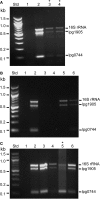Molecular Detection of Legionella: Moving on From mip
- PMID: 21687766
- PMCID: PMC3109421
- DOI: 10.3389/fmicb.2010.00123
Molecular Detection of Legionella: Moving on From mip
Abstract
The detection of Legionella pneumophila in environmental and clinical samples is frequently performed by PCR amplification of the mip and/or 16S rRNA genes. Combined with DNA sequencing, these two genetic loci can be used to distinguish different species of Legionella and identify L. pneumophila. However, the recent Legionella genome sequences have opened up hundreds of possibilities for the development of new molecular targets for detection and diagnosis. Ongoing comparative genomics has the potential to fine tune the identification of Legionella species and serogroups by combining specific and general genetic targets. For example, the coincident detection of LPS biosynthesis genes and virulence genes may allow the differentiation of both pathogen and serogroup without the need for nucleotide sequencing. We tested this idea using data derived from a previous genomic subtractive hybridization we performed between L. pneumophila serogroup 1 and L. micdadei. Although not yet formally tested, these targets serve as an example of how comparative genomics has the potential to improve the scope and accuracy of Legionella molecular detection if embraced by laboratories undertaking Legionella surveillance.
Keywords: Legionella; genomics; molecular testing; virulence.
Figures


Similar articles
-
Identification of Legionella pneumophila-specific genes by genomic subtractive hybridization with Legionella micdadei and identification of lpnE, a gene required for efficient host cell entry.Infect Immun. 2006 Mar;74(3):1683-91. doi: 10.1128/IAI.74.3.1683-1691.2006. Infect Immun. 2006. PMID: 16495539 Free PMC article.
-
Structural comparison of O-antigen gene clusters of Legionella pneumophila and its application of a serogroup-specific multiplex PCR assay.Antonie Van Leeuwenhoek. 2015 Dec;108(6):1405-1423. doi: 10.1007/s10482-015-0594-0. Epub 2015 Sep 28. Antonie Van Leeuwenhoek. 2015. PMID: 26415652
-
Identification of Legionella pneumophila serogroups and other Legionella species by mip gene sequencing.J Infect Chemother. 2012 Apr;18(2):276-81. doi: 10.1007/s10156-011-0324-0. Epub 2011 Oct 21. J Infect Chemother. 2012. PMID: 22015397
-
Identification of mip-like genes in the genus Legionella.Infect Immun. 1990 Sep;58(9):2912-8. doi: 10.1128/iai.58.9.2912-2918.1990. Infect Immun. 1990. PMID: 2387627 Free PMC article.
-
Legionella pneumophila: population genetics, phylogeny and genomics.Infect Genet Evol. 2009 Sep;9(5):727-39. doi: 10.1016/j.meegid.2009.05.004. Epub 2009 May 18. Infect Genet Evol. 2009. PMID: 19450709 Review.
Cited by
-
Characterization of a Novel Species of Legionella Isolated from a Healthcare Facility: Legionella resiliens sp. nov.Pathogens. 2024 Mar 14;13(3):250. doi: 10.3390/pathogens13030250. Pathogens. 2024. PMID: 38535593 Free PMC article.
-
Structure and functional analysis of the Legionella pneumophila chitinase ChiA reveals a novel mechanism of metal-dependent mucin degradation.PLoS Pathog. 2020 May 4;16(5):e1008342. doi: 10.1371/journal.ppat.1008342. eCollection 2020 May. PLoS Pathog. 2020. PMID: 32365117 Free PMC article.
-
Structure, Dynamics and Cellular Insight Into Novel Substrates of the Legionella pneumophila Type II Secretion System.Front Mol Biosci. 2020 Jun 11;7:112. doi: 10.3389/fmolb.2020.00112. eCollection 2020. Front Mol Biosci. 2020. PMID: 32656228 Free PMC article.
-
Molecular diversity and high virulence of Legionella pneumophila strains isolated from biofilms developed within a warm spring of a thermal spa.BMC Microbiol. 2013 Jan 28;13:17. doi: 10.1186/1471-2180-13-17. BMC Microbiol. 2013. PMID: 23350929 Free PMC article.
-
Loop-mediated isothermal amplification for detection of Legionella pneumophila in respiratory specimens of hospitalized patients in Ahvaz, southwest Iran.Infect Drug Resist. 2019 Mar 1;12:529-534. doi: 10.2147/IDR.S198099. eCollection 2019. Infect Drug Resist. 2019. PMID: 30881058 Free PMC article.
References
-
- Aurell H., Etienne J., Forey F., Reyrolle M., Girardo P., Farge P., Decludt B., Campese C., Vandenesch F., Jarraud S. (2003). Legionella pneumophila serogroup 1 strain Paris: endemic distribution throughout France. J. Clin. Microbiol. 41, 3320–332210.1128/JCM.41.7.3320-3322.2003 - DOI - PMC - PubMed
-
- Bencini M. A., van den Brule A. J., Claas E. C., Hermans M. H., Melchers W. J., Noordhoek G. T., Salimans M. M., Schirm J., Vink C., van der Zee A., Jansen R. (2007). Multicenter comparison of molecular methods for detection of Legionella spp. in sputum samples. J. Clin. Microbiol. 45, 3390–339210.1128/JCM.00505-07 - DOI - PMC - PubMed
-
- Benin A. L., Benson R. F., Arnold K. E., Fiore A. E., Cook P. G., Williams L. K., Fields B., Besser R. E. (2002). An outbreak of travel-associated Legionnaires disease and Pontiac fever: the need for enhanced surveillance of travel-associated legionellosis in the United States. J. Infect. Dis. 185, 237–24310.1086/338060 - DOI - PubMed
-
- Cazalet C., Gomez-Valero L., Rusniok C., Lomma M., Dervins-Ravault D., Newton H. J., Sansom F. M., Jarraud S., Zidane N., Ma L., Bouchier C., Etienne J., Hartland E. L., Buchrieser C. (2010). Analysis of the Legionella longbeachae genome and transcriptome uncovers unique strategies to cause Legionnaires’ disease. PLoS Genet. 6, e1000851 10.1371/journal.pgen.1000851 - DOI - PMC - PubMed
LinkOut - more resources
Full Text Sources
Other Literature Sources

